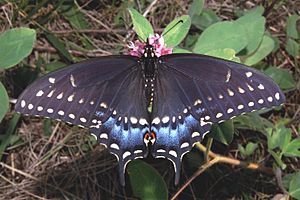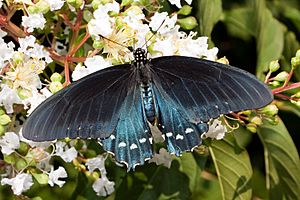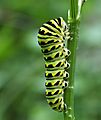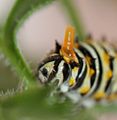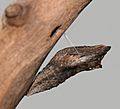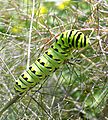Black Swallowtail facts for kids
Quick facts for kids Black Swallowtail |
|
|---|---|
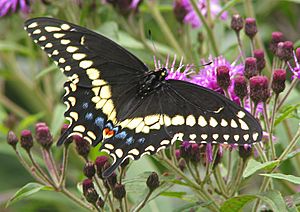 |
|
| Scientific classification | |
| Kingdom: | |
| Phylum: | |
| Class: | |
| Order: | |
| Family: | |
| Tribe: |
Papilionini
|
| Genus: |
Papilio
|
| Species: |
P. polyxenes
|
| Binomial name | |
| Papilio polyxenes Fabricius, 1775
|
|
The Black Swallowtail (Papilio polyxenes) is a type of butterfly. It is also known as the American Swallowtail or Parsnip Swallowtail. You can find this butterfly in many parts of North America.
Contents
- What Does the Black Swallowtail Look Like?
- How Scientists Classify the Black Swallowtail
- Butterflies That Look Like the Black Swallowtail
- Where Black Swallowtails Live
- Where Black Swallowtails Like to Live
- When Black Swallowtails Fly
- How Black Swallowtails Behave
- What Adult Black Swallowtails Eat
- The Black Swallowtail Life Cycle
- Plants Black Swallowtail Caterpillars Eat
- Images for kids
What Does the Black Swallowtail Look Like?
The Black Swallowtail butterfly has a wingspan of about 6.7 to 10 centimeters (2.7 to 4 inches). This is how wide its wings are from tip to tip.
The male butterfly's wings are black on top. They have two rows of bright yellow spots along the edges. On the bottom wing, there's a small blue area between these yellow spots. There's also a red spot with a tiny black dot at the very bottom edge of the lower wing.
The female's wings are also black on top. She has two rows of light yellow spots, but they are smaller than the male's. Her bottom wing has a large blue area between the spot rows. She also has the same red and black spot as the male. The female Black Swallowtail looks very similar to another butterfly, the Pipevine Swallowtail (Battus philenor). This is called mimicry.
The underside of the wings looks the same for both males and females. The top wing is black with two rows of yellow-orange spots. The bottom wing has two rows of orange spots with a blue area in between them.
How Scientists Classify the Black Swallowtail
Scientists group living things based on how they are related. The Black Swallowtail has some interesting relatives!
The Ozark Swallowtail (Papilio joanae) looks exactly like the Black Swallowtail. For a while, scientists thought they were the same. But after studying their DNA, they found that the Ozark Swallowtail is actually more closely related to the Old World Swallowtail (Papilio machaon).
In some places like North Dakota and southern Manitoba, Black Swallowtails sometimes breed with Old World Swallowtails. Their babies are called Kahli Swallowtails. These are a type of hybrid, meaning they have parents from two different species. Scientists are still deciding if Kahli Swallowtails are a new species or a special type of Black Swallowtail.
There's also a special kind of Black Swallowtail called the Desert Black Swallowtail (P. p. coloro). It's a subspecies, which means it's a slightly different group within the same species. You can find it in places like southeastern California. It looks like the male Black Swallowtail but has more yellow, and males and females look alike.
Butterflies That Look Like the Black Swallowtail
Many other butterflies look similar to the Black Swallowtail. It can be tricky to tell them apart!
The Pipevine Swallowtail is very similar to the female Black Swallowtail. But its upper wings don't have yellow spots. Its bottom wing is a shiny, dark blue. The underside of its bottom wing has only one row of orange spots.
The Spicebush Swallowtail (Papilio troilus) also looks like the female Black Swallowtail. It's usually bigger. Its upper wings are black with one row of light greenish-blue spots along the edges.
The Ozark Swallowtail looks exactly like the Black Swallowtail. The best way to tell them apart is by where they live and what plants their caterpillars eat. Ozark Swallowtails live in woodlands. Their caterpillars eat Meadow Parsnip and Yellow Pimpernal.
The Old World Swallowtail has many different forms. One form, called brucei, looks very much like both male and female Black Swallowtails. This form is usually smaller. Also, the black dot in the red spot on its bottom wing is not in the center.
Where Black Swallowtails Live
The Black Swallowtail lives in a wide area. You can find it from southern Canada all the way south to Florida and Costa Rica. It also lives west to the Rocky Mountains and eastern Arizona, and south into Mexico and Peru.
Where Black Swallowtails Like to Live
Black Swallowtails prefer open areas. They live in fields, meadows, deserts, marshes, and near lakes and streams. You can also spot them in farms, lawns, and gardens. They are rarely found in thick forests.
Humans have actually helped the Black Swallowtail a lot. We brought new carrot plants from Europe to North America. Black Swallowtails use these plants for their caterpillars to eat. Before people cleared forests, Black Swallowtails were not very common. They only lived in small open areas like prairies and wetlands. However, in the northeastern United States, there are fewer farms now. This means the Black Swallowtail is becoming less common in that area.
When Black Swallowtails Fly
The Black Swallowtail flies at different times of the year depending on where it lives.
In Canada, you can see them from May to June. In the Colorado Mountains, they fly from June to August. In the eastern parts of their range, they are seen from April to October. In Florida, they fly almost all year, from February to October. In Arizona, they are seen from February to November.
They usually have one group of offspring (babies) in Canada and the Colorado Mountains. In other areas, they can have 2 to 3 groups of offspring each year.
How Black Swallowtails Behave
Black Swallowtails are very fast flyers. Their flight is much quicker than other types of swallowtails. They also fly closer to the ground. When it's cold, they hold their bellies above their wings to stay warm.
Most Black Swallowtails live for about 10 to 12 days as adults. But some can live much longer, up to 35 to 40 days!
What Adult Black Swallowtails Eat
Adult Black Swallowtails drink nectar from many different flowers. Here are some of their favorite food sources:
- Asclepias incarnata – Swamp Milkweed
- Asclepias syriaca – Common Milkweed
- Asclepias tuberosa – Butterfly Weed
- Barbarea vulgaris – Winter Cress
- Cirsium discolor – Thistle
- Dipsacus sylvestris – Teasel
- Echinacea purpurea – Purple Coneflower
- Medicago sativa – Alfalfa
- Syringa sp. – Lilac
- Trifolium pratense – Red Clover
- Vernonia sp. – Ironweed
- Zinnia sp. – Zinnia
Male butterflies also like to visit damp soil and mud. They do this to drink water and get important minerals. This behavior is called puddling.
The Black Swallowtail Life Cycle
The Black Swallowtail goes through a complete change, called metamorphosis. This means it changes from an egg to a caterpillar, then to a chrysalis, and finally to a butterfly.
Mating and Reproduction
Male Black Swallowtails find a special spot, usually on top of a hill. This is their territory. They sit on high branches or plants there. If other male Black Swallowtails come too close, they will chase them away.
Female butterflies fly to the top of the hill to find a mate. If a male and female like each other, their courtship (getting to know each other) can last about 40 seconds. If they don't connect, it might last longer. Mating itself takes about 45 minutes. If a female doesn't want to mate, she will try to fly away quickly, going high up and then diving down.
Egg Stage
Female Black Swallowtails fly close to the ground to find plants for their babies. They lay one egg on each plant. The eggs are laid on the leaves and flowers.
When first laid, the egg is yellow. Later, a red ring forms around its middle, and the top turns red. Just before it hatches, it turns dark gray. It takes about 10 days for an egg to hatch. In one study, females laid between 200 and 430 eggs in total, laying about 35 to 50 eggs each day.
Caterpillar Stage
The caterpillar eats the leaves and flowers of the plant it hatched on. It doesn't build a nest.
When it's young, the caterpillar is black with a white spot in the middle of its body. This spot is called a saddle. It makes the caterpillar look like a bird dropping, which helps protect it from predators.
As it gets older, the caterpillar turns green. It has black bands with orange spots in each band. The caterpillar has a special orange organ called an osmeterium. It smells bad and is shaped like a snake's tongue. It's usually hidden behind its head. The caterpillar pushes it out to scare away predators. The caterpillar can grow up to 5 cm (2 in) long.
Chrysalis Stage
After the caterpillar is fully grown, it changes into a chrysalis. The chrysalis hangs upright from a silk thread. This thread, called a girdle, goes around the upper part of the chrysalis.
The chrysalis can be either brown or green. The Black Swallowtail will hibernate (sleep through winter) as a chrysalis.
Plants Black Swallowtail Caterpillars Eat
Black Swallowtail caterpillars are picky eaters! They only eat plants from the carrot family. These plants are called "host plants." Here are some of the plants they like:
- Anethum graveolens – Dill
- Apium graveolens – Celery
- Berula erecta – Water Parsnip
- Cyclospermum leptophyllum – Slender Celery
- Daucus carota – Queen Anne's Lace
- Daucus pusillus – American Wild Carrot
- Foeniculum vulgare – Anise (also called Fennel)
- Pastinaca sativa – Parsnip
- Petroselinum crispum – Parsley
- Thamnosma montana – Turpentine Broom (only used by the Desert Black Swallowtail)
Images for kids
-
Caterpillar of Papilio polyxenes on Foeniculum vulgare
-
First-instar caterpillar in northeast Georgia


